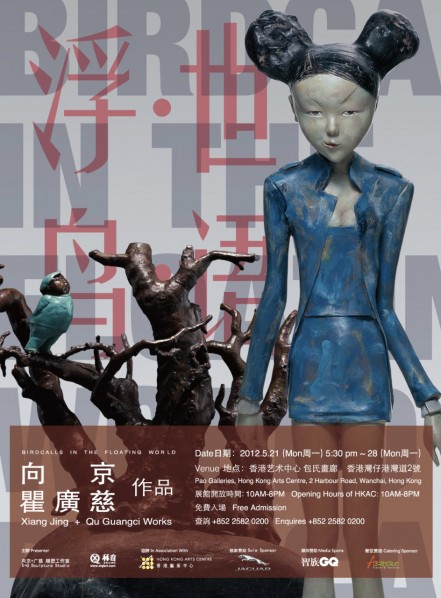
Birdcalls in the Floating World Xiang Jing & Qu Guangci Works at The Pao Galleries Hong Kong Arts Centre
Birdcalls in the Floating World
May 2012 by Xiang Hua
What is the floating world? The Comprehensive Chinese Dictionary explains: the floating world is this world, the here and now. Therefore, the Ukiyo-e School (aka Floating World School) in Japan focused on the depiction of folk customs, performers, warriors, travelling maidens and the landscape. That was the world of the Edo Period. Through the veil of history, it looks quite beautiful.
The floating world is the drifting dust of the mortal world, the red haze of human activity tinting the sun in the sky. The painted scrolls of history tend to begin mildly and move towards liveliness, from cold to energetic. From broad meadows ringing with cowbells and shepherd’s flutes to the wharves and taverns of the bustling cities; from the pride of the loner to the dizzying cacophony of the collective. Those who persist on a lonely aesthetic path are growing increasingly rare, while those who leap into the embrace of gleaming towers like Spiderman will always be lauded by the crowd. These awkward straits are not unique to modern man; the people of the past faced them too. It is just that the explosion of information in this era has magnified them to infinity.
Which awkward straits of this world have Xiang Jing and Qu Guangci depicted in their “floating world?” In this day and age where the collective consciousness drowns out individual thought, throwing a little tantrum or playing with a bit of personality is nothing more than a fashionable gimmick. To be an artist capable of independent thought is truly a blessing. We are very fortunate to see two such people here. Their artworks present a sweeping cold serenity, a state of mind that is a requisite for stepping outside of the floating world in order to see it more clearly. The awkwardness of life is manifested in the state of being observed without being self-aware. Self-ignorance is a good thing, something that will not influence one’s performance on the stage of life. The awkwardness one does not know is the most awkward, and also the most interesting. We are the performers of our own awkwardness as well as the viewers of the awkwardness of others. The performers and the viewers both bathe in the dazzling light of history.
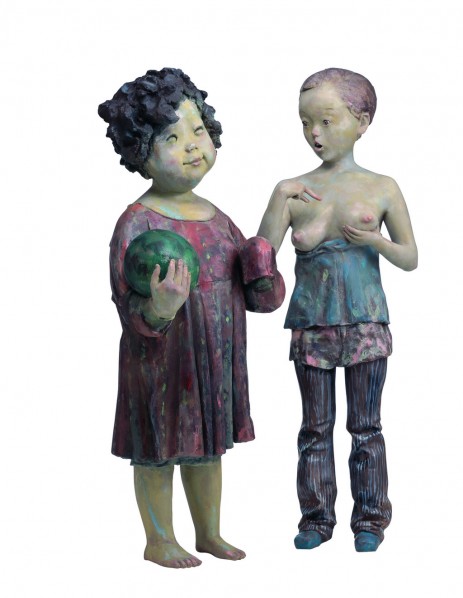
Xiang Jing, Chat, 2010; Fibreglass Painted, H.57cm
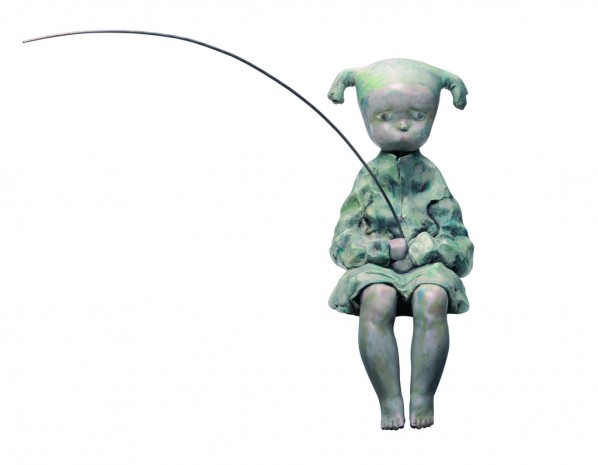
Xiang Jing, Fish, fish, swimming in the water, 2010; Fiber glass, painted, H.42x66x66cm
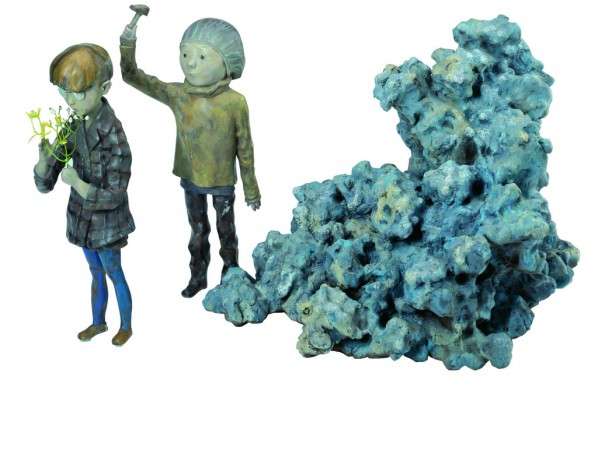
Xiang Jing, The Approaching Butterfly, 2010; Fibreglass, painted, H.40cm
Xiang Jing says, “I have seen happiness,” and takes us to watch it together. With much interest, we discover that happiness usually appears under the guise of unhappiness. In the scroll of the floating world, any condition that the collective is accustomed to has a sense of joy, and anything that fits with the current posture has viewing value. As a result, the people in the street scene appear in various poses, facing the tedium of life with an attitude of seriousness. There are also little characters steeped in the heady atmosphere of art and letters, the sorrow and joy of struggle in the transitive self. Xiang Jing shows us that so called happiness takes on all manner of poses. Poses must be authentic and accented. In the finest details, we see shared glances and passing movements that convey tiny little bits of happiness. Xiang Jing’s artwork reveals a touch of warmth in cold serenity.
The “bird call and response” that Qu Guangci overhears is in a language that is neither human nor avian, and therefore contains many subtleties that can only be sensed, not spoken. In the floating world prosperity grows more desolate the hotter it is. In this way, prosperity can be viewed as the roiling steam created by the friction between an infinite number of lonely individuals. Whether in a concrete jungle or a copper grove, posture is always the most important. Looking out into the distance, the man, bird and tree are as one, a composite, wholly inseparable. The man’s personality cannot leave the bird’s body and the bird cannot leave the tree’s branch. There is no desire to fly, as the sky does not belong to the floating world. Qu Guangci’s artwork reveals a touch of humor in cold serenity.
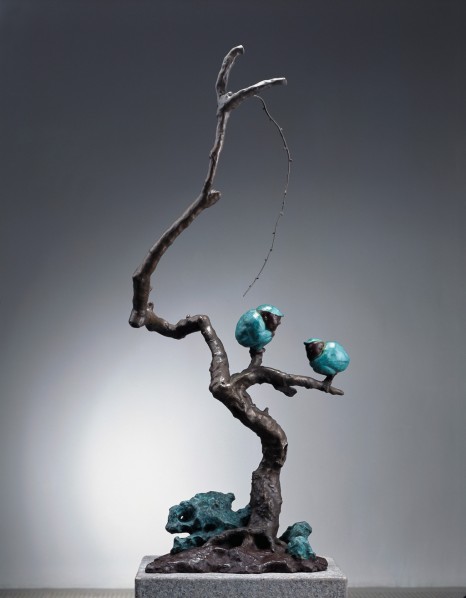
Qu Guangci, Twittering, 2009; Bronze 117x32x52cm
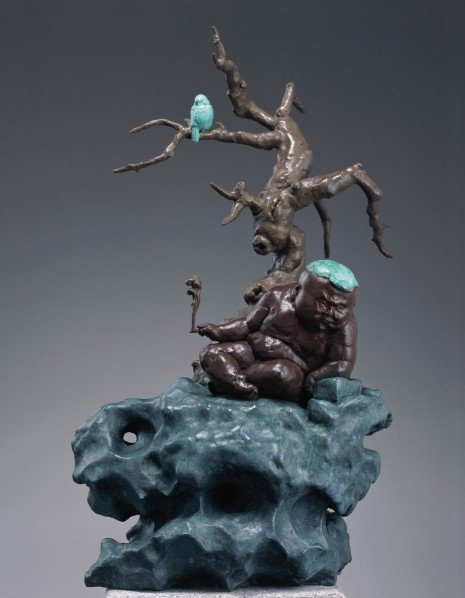
Qu Guangci, Smoke and Mist, 2010; Bronze, H.82x47x32cm
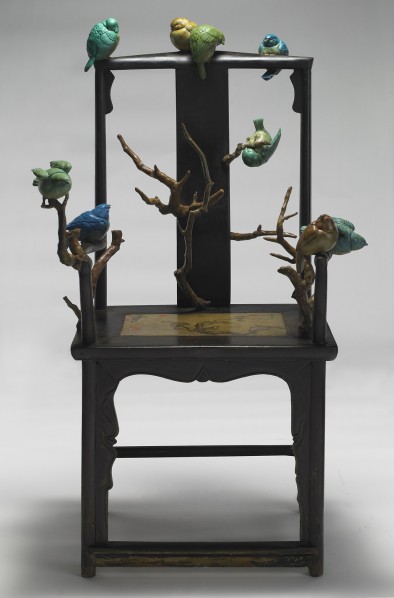
Qu Guangci, My Nature Tree, 2010; wooden chair, painted fiber glass, 121x72x61cm
The visual experience served up by Bird Chatter in the Floating World is transformed by the viewer’s state of mind, just as the flourishing avenues and dark alleys are woven into a network of conveyance for the soul. When viewed with an objective eye, all appears real; when viewed with a more objective eye, it all becomes an illusion. That is how it should be.
(Translated by Jeff Crosby)
Xiang Jing
Renowned Chinese contemporary sculptor Xiang Jing was born in Beijing in 1968 and graduated from the China Central Academy of Fine Arts Sculpture Department. Currently living and working in Beijing. Famous artworks include Your Body and Are a Hundred Playing You? Or Just One?
Xiang Jing’s creative trajectory covered such famous series as Growing Up, The Female Self-Image, Keep in Silence, Naked beyond Skin and Will Things Ever Get Better? From the experience of growing up with the female body and self-awareness, she has steadily elevated her exploration and interpretation of humanity, gradually creating her own unique style to become an outstanding figure of Chinese contemporary art. Her works have been exhibited across Asia, Europe and America and collected by important museums, institutions and individuals around the world.
Through her works, we gain a sense of an artist’s maturing perceptions and insights into life and the world around her. She is not tangled up in ultimate judgments about this world. Instead, she tasks herself with digging into the depths of its existence in search of a
Renowned contemporary Chinese sculptor Qu Guangci was born in Shanghai in 1969 and received his MFA from the China Central Academy of Fine Arts Sculpture Department. Since 1999, Qu has been invited to exhibit his works around the world, including such countries as China, Germany, France, the United States and Southeast Asia. To date, he has held seven solo exhibitions. He formally resigned from his university teaching position in 2007 to found X+Q Sculpture Studio. He currently lives and works in Beijing.
As the youngest artist to win the grand prize at the National Fine Art Exhibition, Qu Guangci became renowned throughout the art world for his sculpting techniques. He attracted widespread attention for his contemporary sculpture language and his post-political expression techniques, and is most famous for his Little Fatty series. Qu’s work often presents a dual nature, providing infinite space for viewer interpretation. Many of his works present a kind of intermediate state between humanity and divinity, neither angels nor demons, neither conflicting nor aligned; the import here is a reflection of a unique Chinese state of affairs.
Qu Guangci
Renowned contemporary Chinese sculptor Qu Guangci was born in Shanghai in 1969 and received his MFA from the China Central Academy of Fine Arts Sculpture Department. Since 1999, Qu has been invited to exhibit his works around the world, including such countries as China, Germany, France, the United States and Southeast Asia. To date, he has held seven solo exhibitions. He formally resigned from his university teaching position in 2007 to found X+Q Sculpture Studio. He currently lives and works in Beijing.
As the youngest artist to win the grand prize at the National Fine Art Exhibition, Qu Guangci became renowned throughout the art world for his sculpting techniques. He attracted widespread attention for his contemporary sculpture language and his post-political expression techniques, and is most famous for his Little Fatty series. Qu’s work often presents a dual nature, providing infinite space for viewer interpretation. Many of his works present a kind of intermediate state between humanity and divinity, neither angels nor demons, neither conflicting nor aligned; the import here is a reflection of a unique Chinese state of affairs.
About the Exhibition
Title: "Birdcalls in the Floating World" Xiang Jing & Qu Guangci Works
Exhibition Period: 5:30pm, 21st May, 2012 (Monday) - 28th May, 2012 (Monday) (Opening Hours 10am~8pm)
Venue: The Pao Galleries Hong Kong Arts Centre
Add: 2 Harbour Road, Wanchai, Hong Kong
Tel: +852 2582 0200
Presented by: X+Q SCUPLTURE STUDIO. For further information please contact xqsculpture@gmail.com.
Presented by: X+Q
In Association with: KHAC (Hong Kong Arts Centre)
Sole Sponsor: Jaguar
Media Sponsor: GQ
Catering Sponsor: Assaggio




























